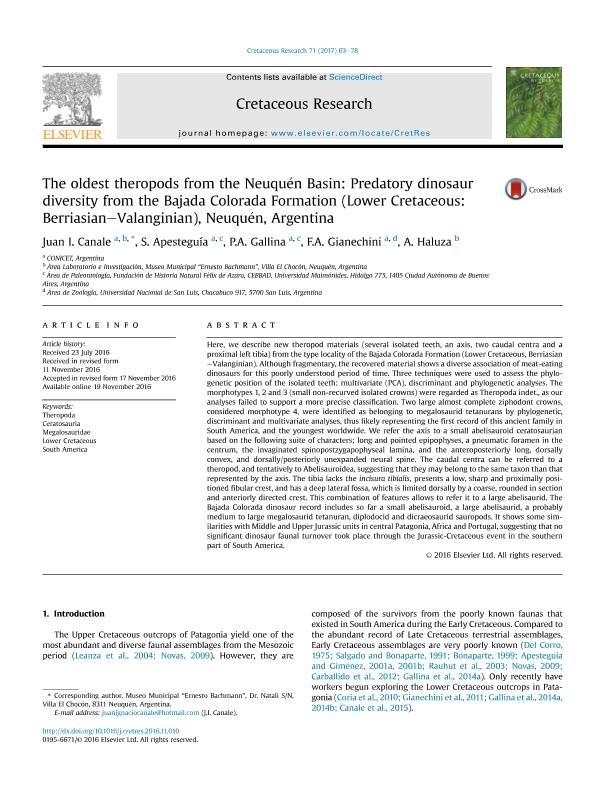Mostrar el registro sencillo del ítem
dc.contributor.author
Canale, Juan Ignacio

dc.contributor.author
Apesteguía, Sebastián

dc.contributor.author
Gallina, Pablo Ariel

dc.contributor.author
Gianechini, Federico Abel

dc.contributor.author
Haluza, Alejandro

dc.date.available
2020-07-08T20:01:30Z
dc.date.issued
2016-11
dc.identifier.citation
Canale, Juan Ignacio; Apesteguía, Sebastián; Gallina, Pablo Ariel; Gianechini, Federico Abel; Haluza, Alejandro; The oldest theropods from the Neuquen Basin: Predatory dinosaur diversity from the Bajada Colorada Formation (Lower Cretaceous: Berriasian-Valanginian), Neuquen, Argentina; Academic Press Ltd - Elsevier Science Ltd; Cretaceous Research; 71; 11-2016; 63-78
dc.identifier.issn
0195-6671
dc.identifier.uri
http://hdl.handle.net/11336/109121
dc.description.abstract
Here, we describe new theropod materials (several isolated teeth, an axis, two caudal centra and a proximal left tibia) from the type locality of the Bajada Colorada Formation (Lower Cretaceous, Berriasian eValanginian). Although fragmentary, the recovered material shows a diverse association of meat-eating dinosaurs for this poorly understood period of time. Three techniques were used to assess the phylogenetic position of the isolated teeth: multivariate (PCA), discriminant and phylogenetic analyses. The morphotypes 1, 2 and 3 (small non-recurved isolated crowns) were regarded as Theropoda indet., as our analyses failed to support a more precise classification. Two large almost complete ziphodont crowns, considered morphotype 4, were identified as belonging to megalosaurid tetanurans by phylogenetic, discriminant and multivariate analyses, thus likely representing the first record of this ancient family in South America, and the youngest worldwide. We refer the axis to a small abelisauroid ceratosaurian based on the following suite of characters; long and pointed epipophyses, a pneumatic foramen in the centrum, the invaginated spinopostzygapophyseal lamina, and the anteroposteriorly long, dorsally convex, and dorsally/posteriorly unexpanded neural spine. The caudal centra can be referred to a theropod, and tentatively to Abelisauroidea, suggesting that they may belong to the same taxon than that represented by the axis. The tibia lacks the incisura tibialis, presents a low, sharp and proximally positioned fibular crest, and has a deep lateral fossa, which is limited dorsally by a coarse, rounded in section and anteriorly directed crest. This combination of features allows to refer it to a large abelisaurid. The Bajada Colorada dinosaur record includes so far a small abelisauroid, a large abelisaurid, a probably medium to large megalosaurid tetanuran, diplodocid and dicraeosaurid sauropods. It shows some similarities with Middle and Upper Jurassic units in central Patagonia, Africa and Portugal, suggesting that no significant dinosaur faunal turnover took place through the Jurassic-Cretaceous event in the southern part of South America.
dc.format
application/pdf
dc.language.iso
eng
dc.publisher
Academic Press Ltd - Elsevier Science Ltd

dc.rights
info:eu-repo/semantics/openAccess
dc.rights.uri
https://creativecommons.org/licenses/by-nc-sa/2.5/ar/
dc.subject
THEROPODA
dc.subject
CERATOSAURIA
dc.subject
MEGALOSAURIDAE
dc.subject
LOWER CRETACEOUS
dc.subject
SOUTH AMERICA
dc.subject.classification
Paleontología

dc.subject.classification
Ciencias de la Tierra y relacionadas con el Medio Ambiente

dc.subject.classification
CIENCIAS NATURALES Y EXACTAS

dc.title
The oldest theropods from the Neuquen Basin: Predatory dinosaur diversity from the Bajada Colorada Formation (Lower Cretaceous: Berriasian-Valanginian), Neuquen, Argentina
dc.type
info:eu-repo/semantics/article
dc.type
info:ar-repo/semantics/artículo
dc.type
info:eu-repo/semantics/publishedVersion
dc.date.updated
2020-07-08T18:47:53Z
dc.journal.volume
71
dc.journal.pagination
63-78
dc.journal.pais
Estados Unidos

dc.journal.ciudad
Amsterdam
dc.description.fil
Fil: Canale, Juan Ignacio. Consejo Nacional de Investigaciones Científicas y Técnicas; Argentina. Provincia del Neuquén. Municipalidad de Villa El Chocón. Museo Paleontológico "Ernesto Bachmann"; Argentina
dc.description.fil
Fil: Apesteguía, Sebastián. Universidad Maimónides. Área de Investigaciones Biomédicas y Biotecnológicas. Centro de Estudios Biomédicos, Biotecnológicos, Ambientales y Diagnóstico. Departamento de Ciencias Naturales y Antropológicas; Argentina. Consejo Nacional de Investigaciones Científicas y Técnicas; Argentina
dc.description.fil
Fil: Gallina, Pablo Ariel. Universidad Maimónides. Área de Investigaciones Biomédicas y Biotecnológicas. Centro de Estudios Biomédicos, Biotecnológicos, Ambientales y Diagnóstico. Departamento de Ciencias Naturales y Antropológicas; Argentina. Consejo Nacional de Investigaciones Científicas y Técnicas; Argentina
dc.description.fil
Fil: Gianechini, Federico Abel. Universidad Nacional de San Luis. Facultad de Química, Bioquímica y Farmacia. Departamento de Bioquímica y Ciencias Biológicas. Área de Zoología; Argentina. Consejo Nacional de Investigaciones Científicas y Técnicas; Argentina
dc.description.fil
Fil: Haluza, Alejandro. Provincia del Neuquén. Municipalidad de Villa El Chocón. Museo Paleontológico "Ernesto Bachmann"; Argentina
dc.journal.title
Cretaceous Research

dc.relation.alternativeid
info:eu-repo/semantics/altIdentifier/doi/http://dx.doi.org/10.1016/j.cretres.2016.11.010
dc.relation.alternativeid
info:eu-repo/semantics/altIdentifier/url/https://www.sciencedirect.com/science/article/pii/S0195667116303445
Archivos asociados
